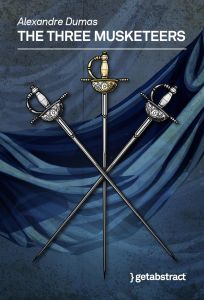
The Three Musketeers
- Historical fiction
- Realism
What It’s About
Adventure for the Ages
Alexandre Dumas, author Victor Hugo once wrote, “is more than French…He is universal…He inspires the soul, the mind and the intelligence; he creates a thirst for reading; he fosters human genius.” Indeed, there are few who can hold a candle to Dumas when it comes to page-turning storytelling, and The Three Musketeers is no exception. This swashbuckling adventure tale – rife with intrigue, passion, bravery, revenge, loyalty and unswerving friendship – has kept readers entertained for nearly two centuries. The novel never flags in its energy, moving swiftly from one incident to the next as it blends the fantastical with real figures and events from 17th-century France. Though some may quibble over Dumas’s free and easy handling of the past, even the most serious-minded reader would struggle not to enjoy the larger-than-life inventiveness of The Three Musketeers.
Summary
About the Author
Alexandre Dumas (née Dumas Davy de la Pailleterie) was born on July 24, 1802, in Villers-Cotterêts, France, to Marie-Louise Élisabeth Labouret – an innkeeper’s daughter – and General Thomas-Alexandre Davy de la Pailleterie. Thomas-Alexandre began using the last name of his Afro-Caribbean slave mother, Dumas, after his nobleman father’s death. The poverty the family suffered after Thomas-Alexandre’s death in 1806 prevented the young Dumas from receiving much formal education. Nevertheless, the bright boy was a voracious reader and, as soon as he was able, became an assistant to a notary. When he was 20, Dumas moved to Paris. He became a clerk to Louis-Philippe, the Duc d’Orleans, who, following the Revolution of 1830, replaced Charles X as king of France. While working for the duc, Dumas began writing plays. Their positive reception allowed Dumas to become a full-time writer. The remarkably prolific Dumas always preferred working with others when writing. His most well-known collaborator, Auguste Maquet, created plot outlines for The Three Musketeers (1844) and The Count of Monte Cristo (1844–1846), among other works. Dumas earned a great deal of money as an author, but his profligate lifestyle meant he was often in debt. Though Dumas married actress Ida Ferrier in 1840, he had a host of mistresses over the course of his lifetime and fathered at least four illegitimate children in addition to his three with Ferrier. Dumas moved to Brussels in 1851 both as a means of escaping his creditors and avoiding Louis-Napoleon Bonaparte, France’s new ruler, who disliked the author. Dumas moved to Russia in 1859 and to Italy in 1861 before returning to Paris in 1864. By the time of his death at age 68 in December 1870, Dumas had authored more than 1,200 works.








Comment on this summary